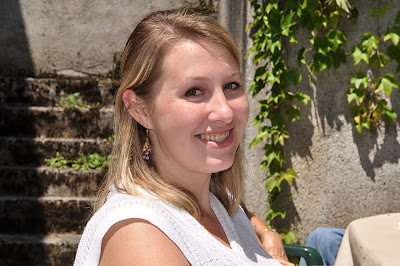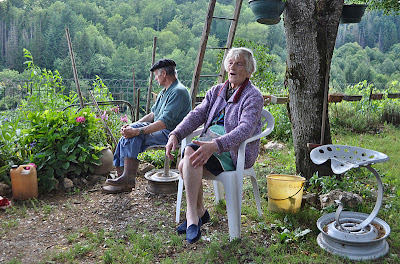As I told you here, there was nothing planned in Sablet to celebrate Bastille Day, July 14, also known as the French Fête Nationale, so we decided to go to La Metairie Neuve, the small family farm near Viane in the Tarn region in Southern France to say bonjour to the aunts, uncles and cousins.
I love going to La Metairie Neuve; I have such good memories especially from my childhood but from more recent return visits like here and here; we would make the trip more often if it was not three and one-half hours each way from Sablet. The same is true about the memories for niece Leslie who was visiting and had not been back to La Metairie Neuve for many years.
So off we went. It was an absolutely beautiful day and we took off under brilliant blue skies early enough so we would arrive at La Metairie Neuve in time for lunch. Our route took us within sight of the Millau Viaduct, the tallest bridge in the world and past the tiny village of Roquefort where the famous sheep's milk blue cheese is created in local caves.
Shortly before arriving at La Metairie Neuve, we drove through Lacaune, famous for its superb charcuterie especially Jambon de Lacaune, ham of Lacaune; the village climate is reportedly perfect for curing ham. We arrived at La Metairie Neuve, the table was set and the aunts and uncles were gathering and cousin Jean Marc was grilling lamb chops on the BBQ grill.
Niece Leslie was happy to be back at La Metairie Neuve and reconnecting with family she had not seen for many years.
After lunch, we went to move some very large rolls of hay into a barn for the horses.
Me resting on the job.
Tonton René wearing his ever present beret hat .
Tonton René and his dog.
At one time, there were 80 - 100 sheep, they were one of the many local farms that supplied sheep's milk for making Roquefort cheese, 12 - 20 cows, a work horse and they raised chickens, ducks and pigeons and grew all their produce. The only live stock which remain are two horses, some chickens, ducks and pigeons. They have a large garden and lots of apple trees, from which they bottle fresh juice each fall.
Cousin Jean Marc with one of his horses.
Tonton René looks out over his garden, actually I should say that its Tata Ida's garden as it is she who plants and takes care of the garden.
Tonton René and tata Ida sit in front of their house; tata Ida is always full of stories. Don't you love the hand made lawn chairs.
One of the barns on the farm with a pretty hydrangea plant.
The family has a long history at La Metairie Neuve. I found out from the aunts that day that they sheltered a Jewish family hiding from the Nazis and their collaborators for several years during WW II, one of several local families who provided shelter and supported the resistance. I hope to find out more about this history and write about it in the future.
Since we were there on the 14th of July, one of the uncles has recently passed away. The other aunts and uncles are aging and La Metairie Neuve will be very different when they are all gone. The future for La Metairie Neuve is uncertain because of French inheritance laws so the cousins are all very anxious. We will be visiting every chance we can.
Bonne journée mes amis et à très bientôt.
We have a beautiful stone village house located in the heart of the medieval village of Sablet in the Vaucluse region of Provence France. Dating from the 17th century, the house was renovated by an Italian stone mason with all of the comforts of a modern home while retaining its authentic Provençal character and charm. On this blog, we share experiences from our visits along with those of our families and friends to Sablet and the South of France.
Sunday, January 22, 2012
Subscribe to:
Post Comments (Atom)











Great post and very interesting. I just love those chairs I would like a couple of them in the garden.
ReplyDeleteThere is so much history around us, and so many people who were in the war. I so wish my French was better, there are so many intriguing stories to be told. These people are all getting older and will not be here to tell their stories for much longer. Looking forward to further history posts from you. Diane
Oh I love your pictures, especially the one of your Ton Ton René sitting in the garden. If I could paint THIS would be the one I want to do :)
ReplyDeleteI imagine he did the tilling and turning in the manure, planting the tomatoes and staking them AND then your Aunt plants the rest and maintains it, harvests it and does the canning (its what happens here haha).
Got to love that Roquefort :)
There are quite a few stories in regards to the resistance, but people kept quiet until about 10 years ago (it was difficult to make them talk before that) when their comrades started dying off...I think they then felt the urgency to tell their story.
What a beautiful place and what a great history! I can't wait for more stories on the history of the house and the family. BTW, I love Tonton Rene! He is the typical little Frenchman with his beret and his country home. Just love it :)
ReplyDeleteAshley
I didn't know you had family in France, that's nice.
ReplyDeleteTonton René should be on a postcard!
ReplyDeleteOh wow, La Metairie Neuve is gorgeous, lucky you... what an idyllic French setting for a party! And I agree with Sara Louise, Tonton Renè definitely needs his own postcard, what an elegant French gentleman.
ReplyDeleteDiane - I love history and I intend to try and see what I can find out about events around and on the family farm.
ReplyDeleteLabergerebasque - You have it right; Tonton René does all of the soil preparation for the garden and then tata Ida takes over.
Ashley - I will share the history I find out.
Megan - We are really fortunate to have family in France, mostly in the South, we have family in Marseille, near Aix-en-Provence, Avignon, Anduze and Montpellier.
Sara and Tuula - Tonton René would be mortified to read your comments. He is one of the most camera-shy people I know. I have to shoot my pictures discretely so he doesn't see me.